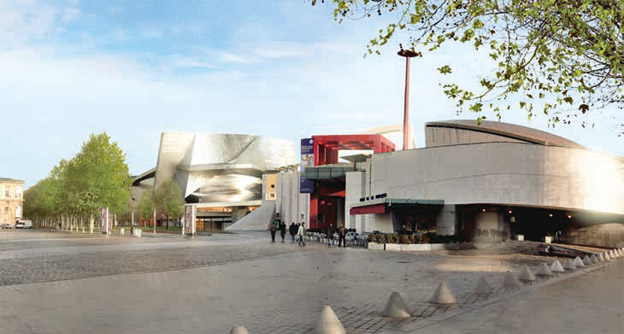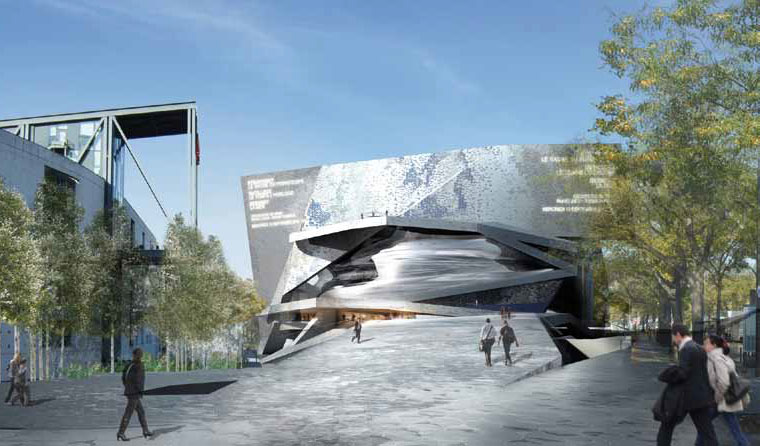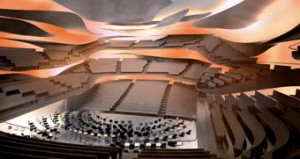In 2006, the project of the Philharmonie de Paris was launched, in 2007 Jean Nouvel won the international architectural competition and on 14 January 2015 the spectacular new concert hall will have its Grand Opening. On that and on the following day, Orchestre de Paris under the baton of Paavo Järvi will play a Gala concert with soloists Renaud Capuçon, violin, Sabine Devieilhe, soprano, Matthias Goerne, baryton and Hélène Grimaud, piano. The concert will be marked by the premiere of a new work by French composer Thierry Escaich.
The main hall of the innovative € 386 million building has a capacity of 2,400 seats, however the Philharmonie combines spaces of all kinds for educational services, recreational activities ranging from the exhibition space to the restaurant and bar, as well as five rehearsal rooms. In fact the new building is called Philharmonie 1, since it forms a unified complex with the current Cité de la Musique, designed by Christian de Portzampac which includes 2 auditoriums of 900 and 250 seats, now called Philharmonie 2.
Laurent Bayle, President of the Philharmonie says: « The project of the Philharmonie, as reflected in the concerts and activities of its first season, meets the features and objectives clearly set out from the outset. Its location, enhancing the existing Cité de la Musique, its symphonic purpose, the permanent residency of the Orchestre de Paris, the regular presence of renowned national and international orchestras, as well as the contribution of current music –jazz, new works, world cultures,etc.–, its priority in educational activities in all its forms, and its focus on the importance of opening to new audiences. »
Philharmonie 1 rises up like a futuristic hill within the Parc de la Villette in the North-East of Paris. The shiny aluminum swirls wrapped tightly around the concert hall contrast with the rest of its matt exterior, defined by elegant angles. From the vast rooftop open to the public, 37 meters high, visitors have an splendid view of the city and the nearby suburbs.
The large auditorium itself feels remarkably intimate thanks to the way the 2400 seats are located, between the parterre, behind the stage and on floating balconies around the central stage. The farthest spectator sits only 32 meters from the conductor. For the project architect Jean Nouvel hired the services of two leading acousticians, Sir Harold Marshall of New Zealand and Yasuhisa Toyota of Japan.
Alongside its two permanent residents – the Orchestre de Paris and the Ensemble intercontemporain – the Philharmonie also has close ties with three associate ensembles: the Orchestre de chambre de Paris, the Orchestre national d’Île-de-France, and Les Arts Florissants.
As a venue, it has great appeal for orchestras such as the London Symphony Orchestra, the Royal Concertgebouw Orchestra of Amsterdam, the Budapest Festival Orchestra, the Chamber Orchestra of Europe, the Berliner Philharmoniker, and others including the Mariinsky Theatre Symphony Orchestra, the New York Philharmonic, the Simón Bolívar Symphonic Orchestra of Venezuela or the West-Eastern Divan Orchestra.
Finally, other French orchestras (such as those of Toulouse, Lille and Lyon, Les Siècles, Les Dissonances, the Orchestre Philharmonique de Radio France, the Chambre Philharmonique
or the Orchestre du Conservatoire de Paris), large Baroque ensembles (such as Les Musiciens du Louvre, Le Concert Spirituel, the Akademie für Alte Musik Berlin or the English Baroque Soloists) and the Accentus chamber choir founded by Laurence Equilbey, all add to the vibrancy of the site.
On weekends, the Philharmonie aims to offer something for everyone with a diverse program of affordably-priced events and activities.
Thanks to wide range of original formats, including concerts, shows geared towards children, participative family concerts, Museum visits, workshops, conferences and even musical child-care, the public is invited to bring to life and appropriate a project that allows everyone to choose their path and enjoy music in their own way.
The ambition of the Philharmonie de Paris is to contribute to the revival of a collective practice of music not only reserved for professionals and versed music lovers. All amateurs, in the broader
sense of the word, will be welcome, would they approach music through practical initiation or active listening.
Specifically, the educational process will first focus on the individual public (families, adults, children, etc.) who will directly benefit, in the appropriate spaces, from a very wide range of activites.
KEY FIGURES
• 340,000 aluminium birds of 7 forms and 4 tints covering the building
• 60,000 m3 of concrete
• 5,000 tons of reinforcement steel
• 4,500 tons of metal framing
• 16 consortiums of companies
• Main auditorium: 2400 seats
• 270 performances (70 of current, jazz and world music
50 with family participation or for young audiences
150 of baroque, classical and contemporary music
More info: http://www.philharmoniedeparis.fr/en/2015-season/discover



























